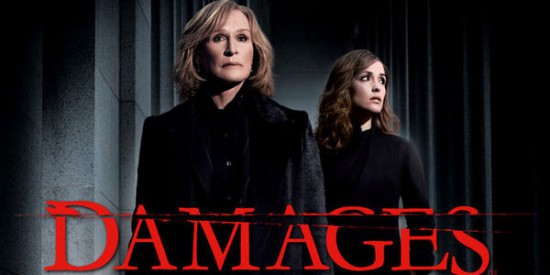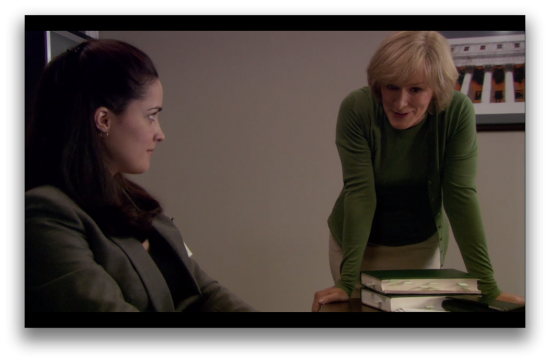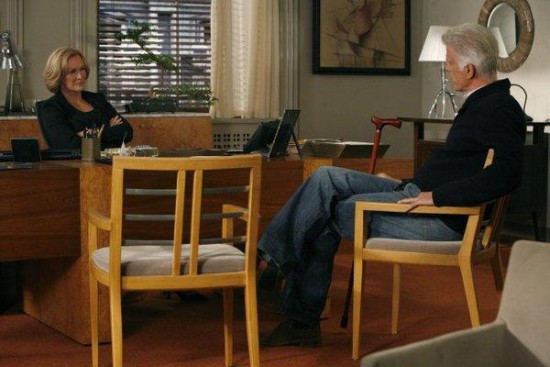Rewarding Damages
Post by Jennifer Lynn Jones, Indiana University
I’m late to seeing everything these days. Sometimes I like it: I’m not jumping on the bandwagon so much as catching up to it in my own time. I don’t have the pressure to keep up with all the conversations. I get to savor the pleasure after everyone else has moved on.
Several friends had watched Damages on Netflix, but I was unsure because of the FX brand. Louie‘s one of my favorite shows, but I was skeptical of how such a male-oriented network would treat a story focused on two female leads. I ultimately started Damages on the recommendation of a friend: she and her family unintentionally stayed up all night one Christmas Eve marathoning it, so enthralled they danced around and pumped their arms whenever the theme music played. It was hard to ignore such a ringing endorsement, and to her credit, I was hooked from start to finish of the first season.
Damages focuses on the law firm of Hewes and Associates, headed by litigator Patty Hewes (Glenn Close). Hewes specializes in class action lawsuits, with the first season centered on a case against Art Frobisher (Ted Danson), a corporate playboy who destroyed his company and workers’ life savings by an alleged illegal stock sale. Frobisher’s former employees hire Hewes and Associates to try the exec in criminal court after a government trial finds him not guilty. New associate Ellen Parsons (Rose Byrne) enters the firm at pre-trial. Talented but naive, Parsons unknowingly has a special connection to the case that makes her indispensable to Hewes. Drawn too deeply into the case, caught in the machinations between Frobisher and Hewes, Parsons pays in unexpected ways that unfold over the course of the first season, starting right with the first episode.
The structure is the best part of the season. The pilot begins with a grainy, frenetic flashforward to what results from Parsons’ role in the Frobisher case. These flashforwards pop up regularly but not consistently so even their appearance keeps you guessing. They reveal a bit more each time, sometimes moving forward but sometimes showing a different perspective of a previous scene. A few flashforward moments are repeated but get more chilling with each view, especially the pilot opener: the repeated sight of just an empty building lobby and closed elevator doors, reminiscent of The Shining‘s corridor scenes, started giving me chills as I understood more about the case and more about what might be happening in those spaces.
The cat-and-mouse game between Hewes and Frobisher also propels the narrative compellingly, not only in the moves they use against each other but also in the questions they create about who’s good and who’s bad. Arguably they’re both, but who’s really the worst? Frobisher is a sociopath, a charmer who will stop at nothing not only to get what he wants, but also to try being liked in spite of it. Hewes is a prototypical antiheroine, hard to like in any obvious way: frosty and spiteful, she uses everyone around her for what she believes to be a bigger, better result to her case. She might be on the right side of the law, but do all her cruel, destructive means justify her desired ends? That question is left open as the season one finale sets up a longer series investigation.
Relatedly, many have written about the gender politics of the show. There’s a lot to mine there, and I’ll catch up with more of those readings as I continue to watch. Of course, there’s not only the male-female battle between Frobisher and Hewes, but also the female-female conflicts between Hewes and Parsons, one of the most commonly discussed parts of the show. The complications in the female relationships can’t be ignored, nor can the similarities between Hewes and Close’s other infamous ballbuster roles, especially Alex Forrest in Fatal Attraction. The connections are intriguing and compel further consideration. I will say that in the battle between Frobisher and Hewes, she eventually comes off as more sympathetic to me: some emotional outpourings and glimpses of a backstory reveal she might have some regrets, although the source of those regrets is left unresolved like other threads in the season one finale.
There are some other pros and a few cons to mention. I liked the pop soundtrack. It was eclectic and evocative, appearing rarely but all the more effectively for that. Donal Logue makes a particularly delightful but brief appearance as a red-pantsed Wall Street blowhard. Finally, it pays to rewatch, which is a big plus in my book. The initial meeting between Frobisher and employee “double-agent” Larry is especially chilling in retrospect.
In terms of cons, Zeljko Ivanek’s accent is atrocious. I’m from the South, and I had no idea what accent he was affecting here. My sense is that it’s meant to reflect on a later character revelation, but it’s not worth inflicting it on the entire series. Lastly, and this is admittedly minor, but there are a few character and actor changes from the pilot to the rest of the season, mostly in rather extraneous family relationships. The main reason I even noticed this (aside from the rewatch) is because Miriam Shor played Parsons’ sister in the pilot, and I’ve always like her so wanted to see more.
Lastly, it seems especially apropos to catch up on Damages during the summer of Mad Men’s finale, as the two premiered within the same mid-July week in 2007, launching what we now talk about as a revolution in basic cable programming. In fact, Mad Men beat Damages for the Best Dramatic Series Emmy for their first seasons. Anyone remember that? I love Mad Men–it’s one of the only shows I refused to time-shift–but having watched both series’ first seasons within the past year, I can honestly say I question that choice.





